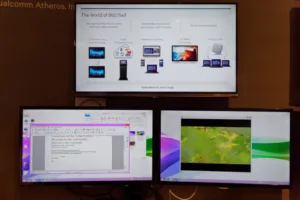Qualcomm, of course, had a big booth and was showing how its latest processors could be used for depth sensing and two different approaches were being shown – one from Mantis using “structured light” while the SoftKinetic technology used “time of flight”.
Qualcomm bought Atheros in 2011 to gain wireless technology, and WiGig developer Wilocity last year. It was using a prototype 802.11ad Wi-Fi (which includes WiGig) system to showcase two use cases of the technology.
First, we looked at an “ip dock” that included a display output, multiple USB ports and a SATA connection as well as Ethernet, all connected to a system using the 60 GHz 802.11ad radio. It seemed to us that the dock could be built into a monitor.
Qualcom showed an 802.11ad dock for display, storage and networking
A second use case was a “fast download kiosk”. A self service kiosk could be used in transport locations (such as airports) to allow very, very fast downloads of HD movies directly to devices in a minute or two. (See our TransferJet story for another version of this). The application, of course, depends on a reasonable installed base of 802.11ad clients.
 Qualcomm showed how 802.11ad could be used to create a download kiosk
Qualcomm showed how 802.11ad could be used to create a download kiosk
Staff at the booth were determined to highlight that 802.11ad does not supercede 802.11ac, but will work with it. The 2.5GHz and 5GHz bands will still be used in conjunction with the 60GHz system to boost range and speeds. The new standard is likely to be widely shipped from early 2016.
Turning to its SoCs, Qualcomm was showing the SnapDragon 805 which is in the Razer Forge TV which is not quite out, but which looked close to production to us. The 810, which is in the LG Flex G2 uses the Mali 430 GPU. The chip is said to produce 30% more compute power with 20% less electrical power. The firm was repeating the UltraHD video demos that it showed at CES and had an UltraHD 10.1″ reference design for a tablet.
We enjoyed looking at the GPU highlights including the “Palazzo” demonstration that used the Unreal 4 engine.

